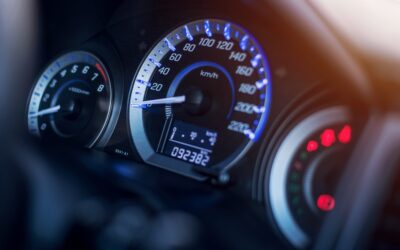Your car’s rear fog lights are there to help other drivers spot you in foggy conditions. It’s a legal requirement that all cars have these fitted.
Knowing when to use fog lights seems like a no-brainer: Turn them on when it’s foggy, and turn them off when it’s not. But is there anything more to it than that?
Let’s take a look at what the current UK driving theory test says.

How to Turn Your Fog Lights On
In the UK Driving Theory Test, you’re required to show your instructor how to switch on your rear fog lights, before explaining when you’d use them.
This is the process:
- Turn your headlights to dipped – Dipped headlights are used in foggy conditions as full-beams will further limit your visibility by illuminating the fog before you. The headlight controls are usually located either on a control panel or a control arm mounted on the steering wheel. They’ll be easy to identify, as they invariably make use of symbols resembling lightbulbs and beams of light.
- Turn on the rear fog lights – Most European cars have a dedicated rear fog light button on the centre console. Again, it should be easy to identify. Most rear fog light buttons feature a symbol depicting an activated headlight with a wavy line through the beams, representing fog.
As for when to use fog lights, let’s take a look at what UK law says.
When To Use Fog Lights – What Does The Law Say?
The UK Driving Theory test simply stipulates that you turn on your fog lights when visibility is at less than 100 metres – about the length of a football pitch – and turn them off when the fog is clear.
Though it’s a legal requirement that all cars have rear fog lights fitted, there’s no legal obligation for motorists to use them. Even in dense fog conditions, you won’t get penalised if you’re caught driving without your fog lights engaged.
However, it is illegal to drive with fog lights activated in clear weather conditions.
When To Use Fog Lights – Misuse & Penalties
There appears to be an emerging trend among young drivers to switch on the rear fog lights at all times But these lights can pose a danger to other drivers. They can be dazzling, especially at night, so misusing them comes with some penalties.
If you’re caught using your fog lights when they’re not needed, at best you’ll be given a verbal warning. However, you might also be levied with a £30 fine and a Fixed Penalty Notice – though no points will be put on your license.
So when it comes to fog lights, it really is as simple as this: Turn them on with dipped headlights when it’s foggy and you’ll be safer and more visible. But never turn them on unless it’s necessary, as you may distract other drivers, and if caught, there may be penalties.
While learning to drive, your instructor should go through all of this with you. If you are currently learning to drive and are worried about what might happen if you do hit a patch of fog, ask your instructor to talk you through the controls in your next lesson – it’ll only take a couple of minutes and it should make you feel more comfortable. If you’re learning with a friend or parent, why not ask them to take you through it too – but remember – if you’re driving with a friend or parent as a supervisor make sure you have learner driver insurance.



